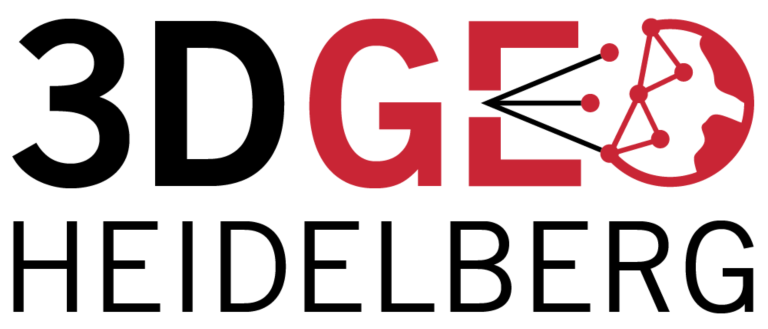Category: Lidar Group
-
STAP19 Workshop and Compact Course Concluded
From 01-04 April 2019, the 3DGeo and FCGL research groups organized STAP19, a compact course and workshop on Spatial and Temporal Analysis of Geographic Phenomena at the Interdisciplinary Center for Scientific Computing (IWR, Heidelberg University). In a mix of lectures, invited talks and hands-on sessions, the participants learned about processing and analysis of 3D geodata,…
-
Multi-Parameter Relief Map from High-Resolution DEMs: A Case Study of Mudstone Badland
Topographic parameters of high-resolution digital elevation models (DEMs) with meter to sub-meter spatial resolution, such as slope, curvature, openness, and wetness index, show the spatial properties and surface characterizations of terrains. The multi-parameter relief map, including two-parameter (2P) or three-parameter (3P) information, can visualize the topographic slope and terrain concavities and convexities in the hue,…
-
Kick-off meeting of BMBF/MOST project “ER3DS” at Heidelberg University
On Tuesday 26 March 2019, the 3DGeo Research Group of Prof. Bernhard Höfle and the newly founded Transdisciplinary Lab (TdLab) Geography (Dr. Nicole Aeschbach) hosted a workshop on “Emission Reduction in Smart Cities Using 3D Spatial Sensing and Analysis (ER3DS)” within the frame of the collaboration and exchange project ER3DS running from 2019 to 2020. The…
-
Multisource and Multitemporal Data Fusion in Remote Sensing: A Comprehensive Review of the State of the Art
The recent, sharp increase in the availability of data captured by different sensors, combined with their considerable heterogeneity, poses a serious challenge for the effective and efficient processing of remotely sensed data. Such an increase in remote sensing and ancillary data sets, however, opens up the possibility of utilizing multimodal data sets in a joint…
-
Brand new 3DGeo logo!
The 3DGeo research group has now a brand new 3DGeo logo! The logo is one result of our recent retreat to Lochau. And here it is: The creative “o” represents the process from raw 3D data via various data models to real-world phenomena – or vice versa. Isn’t that cool? Check out the logo on…
-
Successful 3DGeo group retreat
The 3DGeo research group recently retreated to Lochau, Vorarlberg (AT). In intensive sessions throughout the three days, the members focused on future research, improving working within the group and external representation. A visit to Leica Geosystems in Heerbrugg (CH) complemented the experience, where they were able to visit the manufacturing line for Airborne Laser Scanning…
-
Lukas Winiwarter wins Karl Kraus Award 2019
Our team member Lukas Winiwarter was awarded the prestigious and competitive Karl-Kraus-Nachwuchsförderpreis 2019 for his outstanding research that he did in his diploma thesis. His research “Classification of 3D Point Clouds using Deep Neural Networks” was compiled at the TU Wien (and also at University of Stuttgart in a research visit) under the guidance of…
-
Publication of multi-sensor data from Arctic Siberian permafrost site
A 16-year record (2002–2017) of permafrost, active-layer, and meteorological conditions at the Samoylov Island Arctic permafrost research site, Lena River delta, northern Siberia was just published in Earth System Science Data. The long-term observational data is complemented by high-resolution topographic data acquired by terrestrial laser scanning (TLS) in 2017, when the 3DGeo Research Group joined…
-
How can LiDAR data help to understand early Olmec subsistence in Mexico?
From their beginnings some 4,000 years ago to their decadence around 400 b.c., the Olmec people achieved a high level of sociopolitical complexity and dominated their native geographic territory, the southern Gulf Coast of Mexico. The first Olmec capital of San Lorenzo, Veracruz, was the only site in Mesoamerica that produced imposing monumental stone sculpture…
-
New Highlights at STAP19
Three invited speakers are now joining the compact course and workshop STAP19 on Spatial and Temporal Analysis of Geographic Phenomena organized by the 3DGeo and FCGL at IWR in Heidelberg. Dr. Gottfried Mandlburger (Institute for Photogrammetry, University of Stuttgart) will give a talk on methods of feature and information extraction from geographic 3D point clouds.…
-
Teaching geodata acquisition in and around Heidelberg
As part of the lecture “Geodatenerfassung”, geography students in their first semester turned theory of digital geodata acquisition into practice. Based on their aims and requirements, the students acquired geodata with different methods and sensors. Using a high-end Riegl VZ-2000i terrestrial laser scanner, two groups captured the old town of Heidelberg and a limestone quarry…
-
Visualizing 3D Spatial Data with GigaMesh – Tutorial Videos
A series of video tutorials of GigaMesh has recently become available on YouTube. GigaMesh is a software framework for displaying, processing and visualizing large meshes of 3D spatial data representing 2D surfaces. The most recent tutorial by Paul Bayer and Hubert Mara presents a rapid method of hillshading for a geospatial dataset. The video shows…


